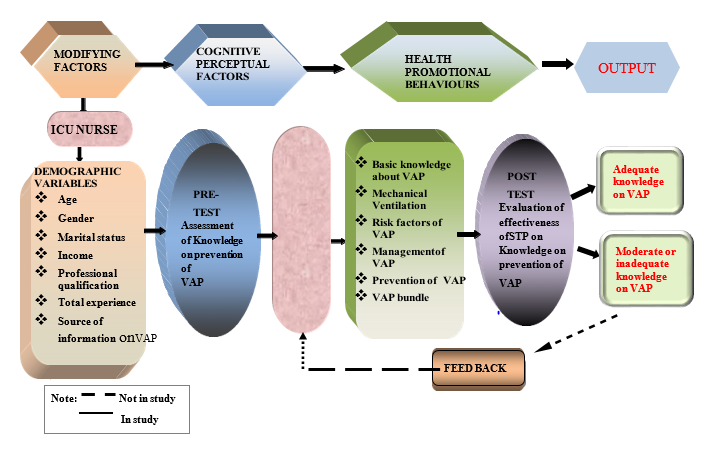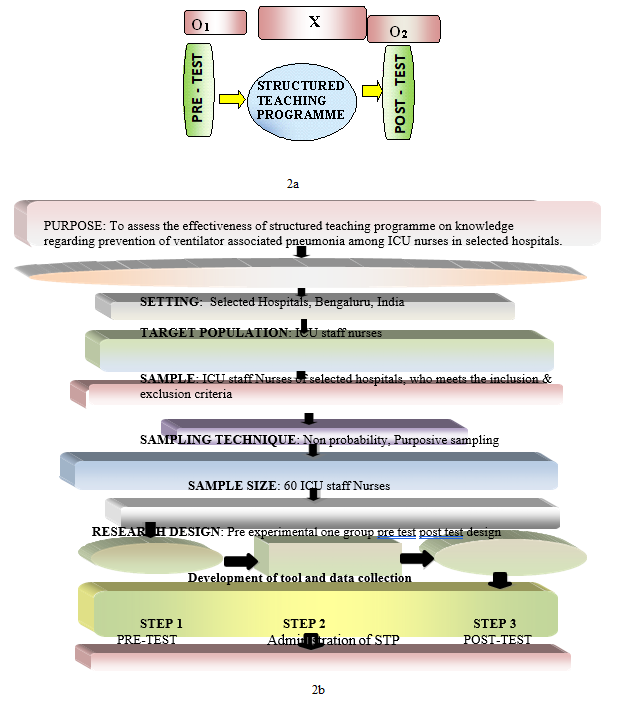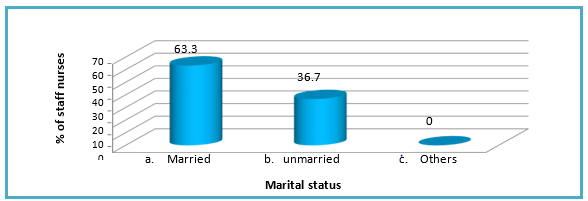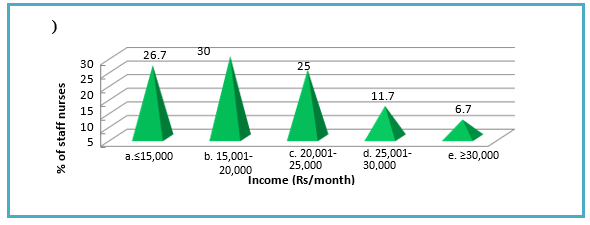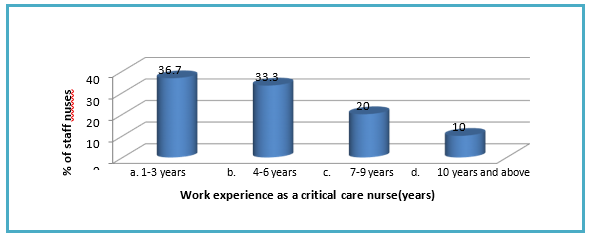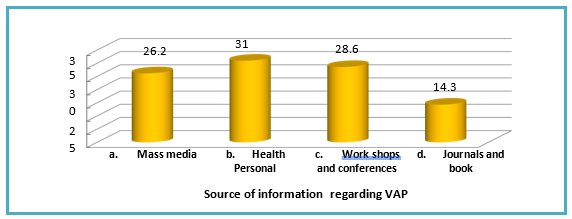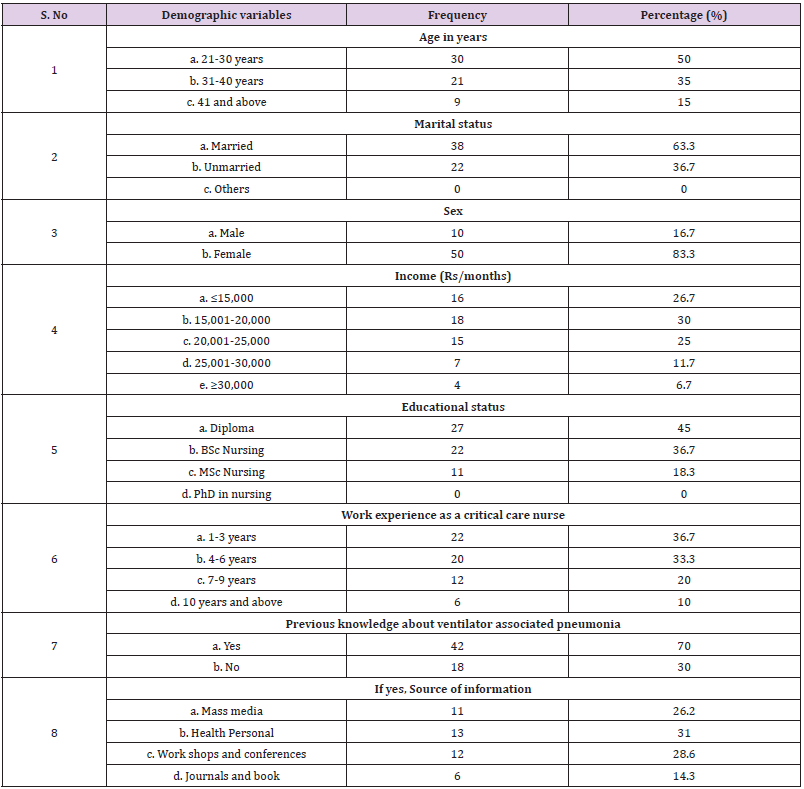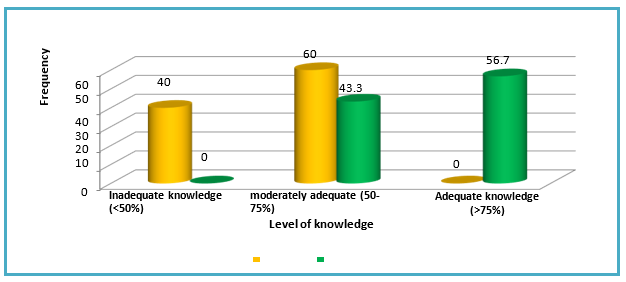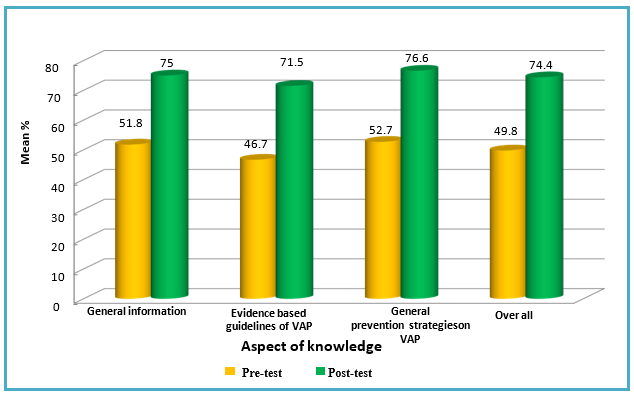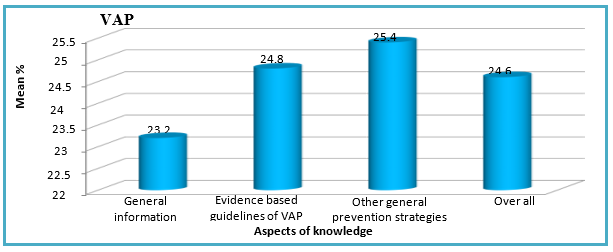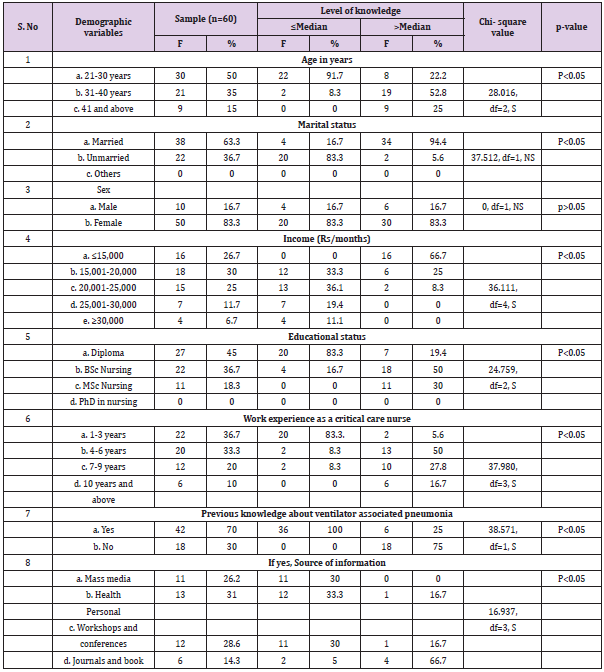ABSTRACT
Ventilator Associated Pneumonia is one of the most common Hospital acquired infections and is associated with increased mortality rate. Prevention of Ventilator Associated Pneumonia (VAP) is very important aspect while caring for mechanically ventilated patient. The nurse’s role in prevention of Ventilator Associated Pneumonia is very significant as they provide care to the critically ill patient round the clock. The study was conducted to Evaluate the Effectiveness of Structured Teaching Programme On Knowledge regarding Prevention Of Ventilator Associated Pneumonia Among the ICU staff Nurses in selected Hospitals. The main objectives of the study were to assess the knowledge regarding prevention of ventilator associated pneumonia (VAP) among ICU staff nurses, To evaluate the effectiveness of structured teaching programme on prevention of VAP among intensive care unit staff nurses and To determine the association between knowledge regarding prevention of VAP among intensive care staff nurses with their selected demographic variable. Methods: An evaluative research approach was used for this study with one group pre-test and post-test without a control group using pre- experimental design, with purposive sampling technique. Information was collected from 60 Registered ICU Nurses using semi- structured knowledge questionnaire. STP was implemented and post-test was conducted after 7 days using same questionnaire. Results: The overall pretest knowledge scores of ICU Nurses on prevention of Ventilator Associated Pneumonia was found to be 49.8% and the overall posttest knowledge scores was found to 74.4% and enhancement is 24.6% in the mean percentage knowledge score was found to be significant at with P<0.001 level for all the aspects under study. There was significant association between knowledge scores & selected demographic variables with age (χ2 28.01), marital status (χ2 37.51), income (χ2 36.11), professional educational qualification (χ2 24.75), total clinical experience (χ2 37.98), knowledge about VAP (χ2 38.5) and source of information on VAP (χ2 16.93) and no association found with gender.
Interpretation & Conclusion: Overall findings showed that there is knowledge deficit among staff nurses regarding prevention of Ventilator Associated Pneumonia and STP was effective in improving their knowledge.
Keywords: Ventilator Associated Pneumonia; Knowledge; ICU Staff Nurses; STP-Structured Teaching Program
Abbreviations: CDC: Centers for Disease Control and Prevention; EBP- Evidence Based Practice; HAI: Hospital Associated Infection; HCAI: Health Care Associated Infection; ICU: Intensive Care Unit; HMEHCW: Humid Moist Exchangers, Health Care Workers
Introduction
Mechanical ventilation is the medical term for artificial ventilation where mechanical means is used to assist or replace spontaneous breathing [1]. This may involve a machine called a ventilator or the breathing may be assisted by an Anesthesiologist, certified registered nurse anesthetist, physician, physician assistant, respiratory therapist, paramedic, or other suitable person compressing a bag or set of bellows. Mechanical ventilation is termed “invasive” if it involves any instrument penetrating through the mouth (such as an endotracheal tube) or the skin (such as a tracheostomy tube) [2]. Health care-associated infection (HCAI), also referred to as―nosocomial‖ infection is defined as: ― An infection occurring in a patient during the process of care in a health-care facility which was not present or incubating at the time of admission. This includes infections acquired in the hospital but appearing after discharge, and also occupational infections among staff. Such infections include urinary tract infection, ventilator associated pneumonia, surgical site infection and blood stream infection [3]. According to the Center for Disease Control and Prevention (CDC, 2012), Ventilator associated pneumonia (VAP) is that type of pneumonia developing 48 hours post intubation. It is diagnosed by the presence of a number of indicators including; manifestations of pulmonary infection as; presence of a disturbance in body temperature > 38◦C or < 36◦C, leukocytosis and purulent tracheal secretions, new or persistent infiltrates detectable on chest radiographs, and positive deep tracheal aspiration culture [4].
Need for the Study
Ventilator-associated pneumonia (VAP) continues to complicate the course of 8 to 28% of patients receiving mechanical ventilation (MV). In contrast to infections more frequently involved organs (e.g., urinary tract and skin), for which mortality is low ranging from 1% to 4%, the mortality rate for VAP ranges from 24% to 50%and can reach 76% in some specific settings or when lung infection caused by high-risk pathogens. Approximately 10%- 28% of critical care patients develop VAP and is the most common and fatal infection of ICU. In India it affects 9-27% of intubated patients and doubles the risk of mortality as compared with similar patients without VAP. VAP may account for up to 60% of all Healthcare- Associated Infections. VAP prolongs ICU length of stay and increases the risk of morbidity and mortality in critically ill patients [5]. A cross-sectional study, involving ICU nurses of major hospitals in Tanzania, was conducted. A structured questionnaire was administered among 116 ICU nurses. Data analysis included descriptive statistics and the independent sample t-test. Results: The mean knowledge score was 3.86(SD = 1.56), based on ten questions (equivalent to 38.6%). Nurses with a degree or higher level of nursing education performed significantly better than the nurses with a diploma or lower level of nursing education (p = 0.004). The mean self-reported compliance score for EBGs for the prevention of VAP was 15.20 (SD = 0.93) which is equivalent to 60.8% based on 25 questions. Conclusion: Considering the severity and impact of VAP, and the higher risks of HAIs in resource, the lower level of knowledge and compliance implies the need for ongoing educational interventions and evaluation of the implementation of the EBGs for VAP prevention by considering the local context [6].
In India, Tirupati, the study was conducted at Sri Venkateshwara Institute of Medical Sciences, in ICU patients with clinically suspected pneumonia were included. The total number of patients for the three years were 1159 in 2011, 903 in 2012 and 1022 in 2013, of whom 247, 297 and 303 had clinical and microbiological evidence of VAP, respectively, as per the modified Clinical Pulmonary Infection Score (CPIS)11 of more than six. During the study period significant growth of pathogens (mono or polybacterial) was found in 247 of 1159 (21.3%) patients in 2011, 297 of 903 (32.9%) in 2012 and 303 of 1022 (29.6%) in 2013. The VAP rates were 44.1, 43.8 and 26.3 per 1000 ventilator days in the three years, respectively [7]. Though there are so many measures done on prevention of VAP and research ongoing still VAP is still persisted. Hand hygiene is the best way to prevent any infection by 50%-60%. Intensive care staff nurses’ knowledge and updates of the ventilator bundle and its applications for preventing VAP is still found lacking and limited. So, researcher felt that need to conduct the study in intensive care staff nurses supported by current research and scientific evidence. Current best practices for patients at risk of VAP can be established by conducting systematic literature reviews on the ventilator bundle and factors related to VAP and by communicating evidencebased findings through education sessions. Education plays a key role in the management of patients with VAP. Use of teaching modules on nursing care and patients at risk of VAP can reduce the rate of VAP significantly. Nurses are resourceful persons in the ICU, who take care of the patients round the clock. If nurses are familiar with knowledge of prevention of VAP, they can apply evidencebased practice and thus reduce the morbidity and mortality rate associated with VAP.
Objectives
1. To assess the knowledge regarding prevention of ventilator associated pneumonia (VAP) among ICU staff nurses.
2. To evaluate the effectiveness of structured teaching programme on prevention of VAP among intensive care unit staff nurses.
3. To determine the association between knowledge regarding prevention of VAP among intensive care staff nurses with their selected demographic variable.
Hypothesis
• H1: There will be a significant difference between the knowledge level on ventilator associated pneumonia among staff nurses before and after the administration of structured teaching programme.
• H2: There will be a significant relationship between knowledge on prevention of ventilator associated pneumonia among staff nurses and their selected socio demographic variables.
Research Variables
i. Independent Variable-Structured Teaching Programme on prevention of VAP
ii. Dependent Variable - Knowledge of Intensive Care Unit nurses regarding prevention of VAP
iii. Attribute Variables-Age, Gender, Marital status, income, Professional qualification, Total clinical experience, Source of information on VAP.
Limitations of the Study
The study is limited to only
• Staff Nurses working in ICU of Manipal, Fortis Hospital and The Bangalore Hospital.
• Staff Nurses who are willing to participate in the study.
• Staff Nurses who are available at the time of data collection.
• Evaluation of the effectiveness of STP is in terms of knowledge scores.
Conceptual/Theoretical Framework
The conceptual framework for this study was developed by the investigator adopted from Health Promotion Model -Pender (1996). It was designed to be a complementary counterpart to the models of health protection; health promotion is directed at increasing client ‘s level of wellbeing.
This model focus on three functions:
1. It identifies the modifying factors. e.g: demographic data that enhance or decrease participation in health promotion.
2. Cues to action (explains the likelihood of a client participating in STP which includes information about meaning and definition of VAP, causes, pathophysiology, clinical manifestations, diagnosis of VAP, medical management and Prevention of VAP.)
3. Participation in health promotion behavior explains, gain in knowledge related to prevention of VAP.
In the present study, the concepts from Pender‘s health promotion model is utilized where the staff nurses act as an agent with their knowledge regarding VAP and its prevention, and providing valuable clues regarding the clinical presentation of VAP and act as a strong member of health team in aiding physicians to diagnose and manage VAP in clinical set up. The focus of the model is to explain the factors that influence the knowledge of staff nurses regarding prevention of VAP. Health promotion behavior of the staff nurses regarding prevention of VAP are influenced by many factors such as age, gender, income, marital status, professional educational qualification, total clinical experience and source of information regarding VAP.If the staff nurses have adequate knowledge regarding prevention of VAP (cognitive perceptual factors), she/he is likely to engage in health promotional activity. If the knowledge is inadequate, the health promotion behavior is interrupted which leads to increase in spread of infection. The findings of this study would assist in evaluating staff nurses’ knowledge regarding prevention of VAP and effectiveness of Structured Teaching Programme for effective identification of deviation from normal (Figure 1).
Review of Literature
The review can be collected under the following headings: Review Related to Incidence and prevalence of VAP, Cause and risk factors of VAP, Prevention of VAP, Knowledge of staff nurses regarding prevention of VAP, Effectiveness of structured teaching programme on prevention of VAP.
Incidence and Prevalence of VAP
A study conducted in Bangkok, Thailand in in the SICU of Siriraj Hospital, Mohidab University for 1-year period which aims to determine the incidence and risk factors of VAP, 228 patients admitted to the SICU were enrolled. VAP occurred in 21 patients (9.21%) or 8.21 per 1,000 ventilator- days. The onset of VAP was late in the majority of patients. The most common organism was A. baumannii (66%), followed by P. aeuruginosa (19%). Compared with non-VAP groups, patients in the VAP group had higher APACHE II score (18 vs. 13, P < 0.001), blood transfusion (95% vs. 75%, P = 0.04), numbers of CVC used (3 vs. 1, P < 0.001), muscle relaxant used (43% vs. 3%, P < 0.001) and steroid used (33% vs. 4%, P < 0.001). The VAP group also had a significantly higher number of intubations, reintubation and self-extubations. Multiple logistic regression showed that numbers of CVC, intubation and surgery, the use of muscle relaxant and steroid were independent risk factors for developing VAP. Ventilator days and ICU length of stay were longer in the VAP group (25 vs. 6 and 25 vs. 7 days, respectively). Lastly, the hospital mortality rate was significantly higher in the VAP group (33% vs. 12%, P = 0.008). The incidence of VAP was 9.2% in the SICU of Siriraj Hospital, which was comparable with previous reports. Bundles of care to prevent VAP should include weaning from a ventilator [8].
Another study conducted in Karnataka, Kolar, India, a total of 100 clinically suspected VAP patients admitted in the ICU were enrolled as per the inclusion criteria. Of the 100 patients analyzed VAP was diagnosed in 71% patients as per the CPIS score. Out of 71 diagnosed VAP cases, 66% were males and 34% were females with a mean age of 41.13 ±1 5.38 (range 18 to 70 years). 26.76% (19) were categorized as early onset VAP while 73.23% (52) were categorized as late onset VAP with a mean duration of ventilation of 5.32 ± 1.36 days. Of the 100 clinically suspected cases included in the study, 71 were confirmed as VAP according to the CPIS score, among which 66% were males and 34% were females with a mean age of 41.13 ±1 5.38 years (range 18 to 70 years) and a VAP rate ranging between 17 – 22/1000 patient ventilated days during the various months of the study period. Patients who developed VAP within 96 hours were categorized as early onset VAP, while after 96 hours were categorized as late onset VAP. The incidence of early onset VAP was 27% while late onset VAP was 73%. Late onset VAP is more common than early onset VAP [9].
Causes and Risk Factors of Ventilator Associated Pneumonia
A study was conducted in China to verify the potential risk factors of ventilator-associated pneumonia (VAP) in patients receiving mechanical ventilation (MV) and to present logistical regression prediction models of VAP occurrence in elderly Chinese patients receiving MV. Total Patients (aged 80 years or above) receiving MV for ≥48 h were enrolled from the Chinese People ‘s Liberation Army (PLA) General Hospital from January 2011 to December 2015. Univariate logistic regression models were performed to explore the relationship between risk factors and VAP. A total of 901 patients were included in the study, of which 156 were diagnosed as VAP (17.3%). The incidence density of VAP was 4.25/1,000 ventilator days. Logistic regression analysis showed that the independent risk factors for elderly patients with VAP were COPD (OR =1.526, P <0.05), intensive care unit (ICU) admission (OR=1.947, P <0.01), the MV methods (P <0.023), the number of antibiotics administered (OR=4.947, P <0.01), the number of central venous catheters (OR=1.809, P <0.05), the duration of indwelling urinary catheter (OR=1.805, P <0.01) and the use of corticosteroids prior to MV (OR=1.618, P <0.05). Study concluded VAP occurrence is associated with a variety of controllable factors including the MV methods and the number of antibiotics administered. A model was established to predict VAP occurrence so that high-risk patients could be identified as early as possible [10].
A prospective observational study was carried out in Madhya Pradesh, India to determine the incidence, various risk factors and attributable mortality associated with VAP and various bacterial pathogens causing VAP in the ICU. VAP was diagnosed using the clinical pulmonary infection score. Endotracheal aspirate (ETA) and bronchoalveolar lavage (BAL) samples of suspected cases of VAP were collected from ICU patients. Results showed the incidence of VAP was 57.14% and the incidence density of VAP was 31.7/1000 ventilator days. Trauma was the commonest underlying condition associated with VAP. The incidence of VAP increased as the duration of mechanical ventilation increased and there was a total agreement in bacteriology between semi-quantitative ETAs and BALs in the study. The overall mortality associated with VAP was observed to be 48.33% [11].
Review Related to Prevention of VAP
A Pre- and post-intervention observational study conducted in Paris, France of 2 yrs multifaceted programme was done in 20- bed medical ICU. A total of 1649 ventilator-days were observed. Compliance assessment consisted of five 4-wk periods (before the intervention and 1 month, 6 months, 12 months, and 24 months thereafter). Results showed that Hand-hygiene and PPE use compliances were initially high (68% and 80%) and remained stable over time. Compliance with all other preventive measures was initially low and increased steadily over time (before 2-yr level, p < .0001): backrest elevation (5% to 58%) and tracheal cuff pressure maintenance (40% to 89%), orogastric tube use (52% to 96%); gastric over distension avoidance (20% to 68%); good oral hygiene (47% to 90%); and nonessential tracheal suction elimination (41% to 92%). To assess overall performance of the last six preventive measures, using ventilator-days as the unit of analysis, a composite score for preventive measures applied (range, 0–6) was developed. The median (interquartile range) composite scores for the five successive assessments were 2 (1–3), 4 (3–5), 4 (4–5), 5 (4–6), and 5 (4–6) points; they increased significantly over time (p < .0001). VAP prevalence rate decreased by 51% after intervention (p < .0001). The study concluded that the increased compliance with preventive measures directly dependent on healthcare workers’ bedside performance [12].
A randomized study is done for 1 year in tertiary care hospital at Rajasthan, India on ventilated patients aged from 24 to 80 yrs, for each patient prevention ventilator bundle checklist by CDC was followed, which include 7 strategies to reduce VAP incidence and mortality rate. According to the 2004 CDC (Center for Disease Control) guidelines, hands should be washed before and after patient contact and also in between patient contact. Chlorhexidine has been shown to be effective in the control of ventilator-circuit colonization and pneumonia caused by antibiotic-resistant bacteria. Oropharyngeal decontamination with Chlorhexidine solution has also been shown to reduce the occurrence of VAP in patients undergoing cardiac surgery. VAP, although often preventable, has a large impact on morbidity and mortality. In order to further decrease the incidence of VAP, protocols and monitoring tools must be developed [13].
Knowledge on Staff Nurses Regarding Prevention of VAP
ICU nurses have been found to be in the best position to put knowledge into practice as they are at the patient ‘s bedside 24 hours daily providing nursing care and therefore play an important role in the prevention of VAP. Various measures to prevent VAP have been reported in the literature, however there are very few data concerning nurses ‘knowledge on VAP prevention and the level of their practice, as well as factors that may influence their application at the bedside, lack of knowledge may be a barrier to practice.
A cross-sectional study included 219 nurses working in 14 intensive care units at 11 Guilan hospitals. The questionnaire consisted of three parts of demographic information, nurses’ knowledge of evidence-based guidelines for the prevention of VAP, and the barrier for the implementation of these guidelines.
Results: Of the 219 nurses, 171 (response rate 78.1%) participated in this study, and their mean knowledge score was 4.6. There was no significant relation between nurses’ knowledge score and their work experience (P = 0.327), education degree (P = 0.189), and their position (P = 0.168).
Conclusion: The level of knowledge regarding VAP prevention seems inadequate in this study. Although having knowledge about the principles of evidence-based care cannot guarantee the implementation of these principles, lack of knowledge may be a potential barrier to adherence to evidence-based guidelines for the prevention of VAP [14].
Effectiveness of Structured Teaching Programme
A study was conducted in Jordan to identify the level of nurses’ knowledge of ventilator-associated pneumonia and prevention measures before and after an educational Programme. Pre- and post-intervention observational study was conducted. Data based on a self-reported questionnaire from 428 nurses who worked in intensive care units were analysed. Paired t-tests were used to test research questions. Results found more than three-quarters of nurses had a low knowledge level regarding pathophysiology, risk factors and ventilator-associated pneumonia preventative measures. Nurses showed significant improvements in mean scores on the knowledge level of ventilator-associated pneumonia and prevention measures after an educational programme (p<0.05) [15].
A Study was conducted in Guntur, Andhra Pradesh, India to find the effectiveness of structured teaching programme by assessing the knowledge gain evaluated before and after implementing the structured teaching programme. One group pre-test, post-test design was used to conduct the study. Total 30 nurses were included in study and result showed majority of nurses 21 (96.6%) were having inadequate knowledge on prevention of Ventilator associated pneumonia and about 9(30%) were having average knowledge. The majority 29(96.6%) of nurses were having above average knowledge on prevention of VAP and about 1(3.33%) were having average knowledge on prevention of VAP. In pre-test, 21(96.6%) were having inadequate practices on prevention of VAP. In posttest, there was good improvement in their practices. Conclusion: The study findings revealed that majority of the respondents were not having sufficient knowledge and practices on prevention of VAP. Knowledge and practices on VAP had significantly improved after administering of structured teaching programme [16].
Methodology
Research Approach
An evaluative research approach was used for this study.
Research Design
The research design selected for the present study is evaluative research design Pre-Experimental, One Group Pre-test and Post- Test Design (Figure 2).
• Descriptive analysis
• Testing of hypothesis by using inferential statistics
• Interpretation of results.
Note: O1= Pre-test assessment of knowledge regarding prevention of Ventilator associated pneumonia among ICU staff nurses
X = Administration of Structured teaching programme regarding prevention of Ventilator associated
pneumonia among ICU staff nurses
O2= Post-test assessment of knowledge regarding prevention of Ventilator associated pneumonia among ICU staff nurses
Figure 2: a. Schematic Representation of Research Design
b. Schematic Representation of Research Methodology.
Finding and Conclusion and Dissemination of Results
Variables of the Study
Independent Variable: Structured teaching programme on knowledge regarding prevention of ventilator associated pneumonia among ICU staff nurses in selected hospitals, Bengaluru.
Dependent Variable: Knowledge of ICU staff nurses regarding prevention of ventilator associated pneumonia among ICU staff nurses in selected hospitals.
Attribute Variable/Demographic Variable: Personal characteristics which include Age, gender, income, Marital status, Professional Educational qualification, Total clinical experience in years, Source of information regarding VAP.
Setting of the Study
The study was conducted in the Fortis Hospital which is 8.9Km, The Bangalore Hospital which is 8.5Km from Global College of Nursing, Bengaluru. The criteria for selecting these setting was geographical proximity, feasibility for conducting the study, availability of the required sample and familiarity of the investigator with these settings.
Population: The target population of the study was registered ICU Staff Nurses working at Fortis Hospital and The Bangalore Hospital, Bengaluru, Karnataka.
Sample Size and Sampling Technique
The sample consists of 60 Registered Staff Nurses working in ICU. In the study, purposive sampling method through nonprobability convenient sampling approach was used for the selection of Nurses.
Criteria for Selection of the Sample
Inclusion Criteria: Nurses who are working in Intensive Care Unit at selected hospitals, available at the time of data collection, willing to participate in the study.
Exclusion Criteria: Nurses who are working less than one year in ICU, have undergone special training programme on the topic.
Limitations of Study
The study is limited to:
1. Selected hospitals.
2. The period of data collection was only 4 weeks.
3. Critical care nurses who are working in ICU.
Selection and Development of Tool
A semi-structured knowledge questionnaire was selected for the study. It was considered to be the most appropriate instrument to elicit the best response from subjects.
Development of the Tool: The steps carried out in preparing the tool is: Literature review, Preparation of blue print, Establishment of validity and reliability.
Review of Literature: Review of literature from books, journals, published and unpublished research studies were reviewed and used to develop the tool. The semi-structured Knowledge Questionnaire was developed after taking review of research and non-research literature, as per CDC guidelines, Expert ‘s opinions and suggestions and a blueprint was prepared, and knowledge items were developed for the semi- structured questionnaire.
Description of the Semi-Structured Knowledge Questionnaire: It consisted of two parts
Section I: It included the personal and socio-demographic data which contains Age, gender, marital status, income, years of experience in ICU, education level and previous knowledge on VAP and source of information about prevention of VAP.
Section II: a semi-structured knowledge questionnaire was prepared which consists of 30 questions. Blueprint was prepared and items were prepared in 3 sections (A, B and C)
• Part A consist of 08 items related to knowledge regarding definition (01), risk factors (04), causative organism (01), clinical manifestation (01), diagnosis (01).
• Part B with 10 questions which measure evidenced based knowledge; questions were adopted from a reliable questionnaire developed by Vandijick [17].
• Part C with 12 questions are adopted from a reliable source by Tablan et al. recommended by CDC guidelines 45,46 and researcher with the help of ICU experts and were modified and/ or created for the purpose of this study to reflect VAP prevention strategies. The correct answers were based on internationally accepted guidelines and carefully discussed by the hospital panel of experts [18,19]. The questionnaire comprises 10 validated questions; other questions added were formulated by the researcher with the help of literatures, CDC recommendation and ICU experts. Eight experts reviewed the items to determine if all questions were clearly worded and would not be misinterpreted. The total knowledge scores ranged from 0 – 30. The score is further divided statistically as follows.
Scoring of the Items
Each correct answer was given a score of one‘mark and wrong answers zero‘ score.

To find out the association with the selected variables, the knowledge aspect was categorized into three groups (Table 1).
Structured Teaching Programme
A structured teaching programme was developed through the following steps- Formulation of objectives, Review of literature, Consultation with the experts, Preparation of the first draft of the STP, Content Validation, Preparation of the final draft of the STP regarding prevention of ventilator associated pneumonia.
Development of Content Blueprint: A blueprint of objectives and content items pertaining to knowledge regarding Ventilator Associated Pneumonia and its prevention was prepared for the construction of semi-structured knowledge questionnaire.
Objectives were distributed under the following learning areas.
1. General information regarding Ventilator Associated Pneumonia.
2. Evidence based guidelines on Prevention of Ventilator Associated Pneumonia.
3. General preventive strategies on Prevention of Ventilator Associated Pneumonia.
4. The same blueprint was considered for the construction of STP.
Preparation and Development of Structured Teaching Programme
Preparation of First Draft of STP: First draft of STP was developed, keeping in mind the objectives, criteria checklist, literature reviewed and the opinion of experts. The main factors that were kept in mind while preparing STP were: professional qualification of the subjects, method of teaching to be adopted, simplicity of language, and relevance of teaching aids.
Content Validity of the Teaching Plan: The initial draft of STP was given to experts in the field along with the tool. The suggestions were incorporated.
Preparation of Final Draft of STP: The final draft of STP was prepared after incorporating expert ‘s suggestion.
Selecting the Method of Teaching: Lecture cum discussion method was selected as an appropriate method of teaching staff nurses. It was planned to teach in small groups. LCD, Flash cards, chalk board and charts were considered appropriate to increase the impact of teaching.
Planning to Implement the Structured Teaching Programme: The time and date to implement the structured teaching programme was planned and decided in co-ordination with the Medical Superintendent/Director and the Nursing superintendent of the concerned hospitals.
Determining the Method of Evaluating the Structured Teaching Programme: The evaluation of structured teaching programme was planned through conducting post-test after 7 days of implementation of structured teaching programme.
Description of Structured Teaching Programme
The STP was titled-Prevention of Ventilator Associated Pneumonia. It consisted of the following content area: definition, etiology and incidence, types, pathogenesis and risk factors, clinical manifestations, diagnostic evaluations, preventive measures and VAP Bundle, Summary and Conclusion.
Content Validity
The semi-structured knowledge questionnaire and structured teaching programme were content validated by giving to 6 experts from nursing field, 1 ICU physician and 1 statistician. Their suggestions were taken into consideration and the modifications were incorporated in finalizing the tool and STP.
Reliability
The semi-structured knowledge questionnaire was administered to 6 subjects. In order to establish reliability, the Test- Retest method was used. The reliability of the tool was 0.94. So, the tool was found to be reliable (Table 2).
Karl Pearson‟s formula:

Pilot Study
A pilot study was conducted from 01-5-2019 to 07-05-2019 at Manipal Hospital, Bengaluru. Administrative and Medical ICU Consultant approval was obtained. The purpose of the pilot study was to evaluate the effectiveness of STP, find out the feasibility of conducting the final study and determine the method of statistical analysis. After selecting six staff nurses by purposive sampling technique, pre-test was administered by using the semi-structured knowledge questionnaire. On the same day, STP was administered for 45min. After 7days, the post-test was administered by using the same semi- structured knowledge questionnaire to evaluate the effectiveness of STP on the knowledge regarding Prevention of VAP.
Result: The mean percentage knowledge score in post-test (81%) was higher than the mean percentage knowledge score in pre-test (40%). The enhancement mean percentage knowledge scores (41%) were found to be significant at 5% (P<0.05) level. The findings of the Pilot Study revealed that the Study is feasible.
Data Collection Procedure for Main Study
Permission from the Concerned Authority: Formal permission was obtained from administrative department and medical superintendent of Fortis Hospital and The Bangalore Hospital.
Period of Data Collection: The data was collected from 15-5- 2019 to 15-6-2019 in Fortis Hospital and from 25-5-2019 to 25-6- 2019 The Bangalore Hospital.
Plan of Data Analysis: The data obtained was analyzed using both descriptive and inferential statistics.
Descriptive Statistics: Frequencies and percentage distribution were used for analysis of socio demographic characteristics and the level of knowledge. Mean, Mean percentage and standard deviation were used for analyzing pre- test and post-test scores.
Inferential statistics: Application of paired t‘test to ascertain whether there is significant difference in the mean knowledge score of pre-test and post-test values. Application of chi-square to find the association between socio demographic variables with knowledge scores.
Protection of Human Rights
The proposed study was conducted after the approval of dissertation committee of the college. Ethical clearance certificates were obtained. Permission was obtained from the administrative department and medical Superintendent of Fortis Hospital and The Bangalore Hospital. The written consent of the participant was obtained before the data collection. Assurance was given to the participants regarding the confidentiality.
Results
The samples were 60 ICU staff nurses. The data collected was tabulated, analyzed and interpreted by using descriptive and inferential statistics based on the objectives of the study. Analysis was done based on the objectives and hypothesis of the study. The level of significance was set at 0.05%. Organization of the study findings. The substantive summary of the analysis was under the following sections
• Section 1: Description of demographic variables of staff nurses in selected hospitals.
• Section 2: Assessment of pre and posttest knowledge regarding ventilator associated pneumonia (VAP) of staff nurses.
• Section 3: Effectiveness STP on knowledge regarding ventilator associated pneumonia among staff nurses.
• Section-4: Association between the knowledge regarding ventilator associated pneumonia with selected demographic variables.
Section 1: Description of Demographic Variables of Staff Nurses in Selected hospitals (Table 3) Figure 3 depicts the distribution of staff nurses by age. The above table shows that 50% of respondents were in the age group of 21-30 years followed by 35% in the age group of 31-40 years and 15% in the age group of 41 years and above. Figure 4 depicts the distribution of Staff Nurses by marital status. The above table indicates that 63.3% of nurses were married and 36.7% of the respondents were unmarried. Figure 5 depicts the distribution of staff nurses by gender. In relation to gender, majority 83.3%of nurses were found to be females as compared to males 16.7% in the study group. Figure 6 depicts the distribution of staff nurses by income. In relation to income, majority 30%of nurses were earning Rs.15,001-Rs.20,000, 26.7% were earning < Rs.15,000, 25% were earning Rs.20,000-Rs.25,000, 11.7% were earning Rs.25,000- Rs.30,000 and only 6.7% were earning equal to Rs.30,000 in this study group. Figure 7 depicts the classification of Staff Nurses by professional educational qualification. With respect to professional educational qualification it was observed that 36.7% of the respondents were graduates in nursing and 45% of respondents were with Diploma in Nursing and only 18.3% were post graduate in Nursing, none has doctorate in Nursing in this study group. Figure 8 depicts the distribution of Staff Nurses by Total Clinical Experience in critical care. In relation to total clinical experience in critical care majority 36.7% of the nurses had 1-3 years of clinical experience, 33.3% had 4-6 years of clinical experience, 20% had 7-9 years of clinical experience and 10% had above 10 years of clinical experience. Figure 9 depicts the distribution of staff nurses by previous information on VAP. In relation to this, majority 70% of nurses were having information about VAP and 30% were not aware about VAP information in the study group. Figure 10 shows the classification of staff nurses based on the source of information on VAP. 31% of the nurses gained information about VAP through health personnel, 28.6% from workshops and conferences, 26.2% from mass media, 14.3% from journals and books.
Section 2: Assessment of Pre and Post Test Knowledge Regarding Ventilator Associated Pneumonia Among ICU Staff Nurses (Tables 4a & 4b).
The above Table 4a depicts the frequency and percentage of staff nurses according to level of knowledge regarding ventilator associated pneumonia. Of the sample, 24(40.0%) of staff nurses had inadequate knowledge, 36(60.0%) of them had moderately adequate knowledge and none of them had adequate knowledge in pretest But, in posttest 26(43.3%) had moderately adequate knowledge, 34(56.7%) had adequate knowledge and none of them had inadequate knowledge. It evidences the proportion of increase in level of knowledge. Figure 11 reveals that in pre–test, 40% of the nurses possess inadequate knowledge and remaining 60% of nurses possess moderate knowledge. Whereas, in the post – test results, 56.7% of them had adequate knowledge and 43.3% had moderate knowledge. The above Table 4b shows the range, mean, SD and mean score percent of pre and posttest knowledge regarding prevention of ventilator associated pneumonia among staff nurses. In pretest, the overall knowledge scores were ranging within 7-21 with mean and SD of 14.95 and 4.31 over the maximum score of 30. The pretest mean percentage was 49.8%. But after STP, the scores were ranging within 15-29 with mean and SD of 22.33 and 4.07. The posttest mean percentage was 74.4%. There was an increase of knowledge. Similarly, the mean score percent was computed over the different aspect of knowledge regarding prevention of ventilator associated pneumonia, found to be remain increased. It evidenced the increase in knowledge regarding ventilator associated pneumonia among staff nurses after the administration of STP. Figure 12 depicts that overall pre test mean knowledge score was 49.8% and post test value was 74.4%.with enhancement of 24.6%. There exists a statistical significance in the enhancement of knowledge scores indicating the positive impact of intervention programme.
Table 4a: Frequency and percentage distribution of staff nurses according to pre and posttest level of knowledge regarding ventilator associated pneumonia. n=60.
Table 4b: Mean and SD of pre and posttest knowledge regarding ventilator associated pneumonia among staff nurses. N= 60.
Section 3: Effectiveness STP on Knowledge Regarding Prevention of Ventilator Associated Pneumonia Among Staff Nurses (Table 5).
The above Table 5 shows that the increase in knowledge on the overall aspect of knowledge as well as the knowledge regarding different aspects regarding ventilator associated pneumonia. Of the maximum score of 30, in pretest the subjects had the mean difference of knowledge was 7.38 with mean gain of 24.6%. It was statistically significant (p<0.001). Similarly, the mean difference between the pre and posttest knowledge over the different aspects of knowledge also were found to be remain significant (p<0.001). These statistical outcomes revealed that the intervention of STP is effective in improving the knowledge regarding prevention of ventilator associated pneumonia among staff nurses. Figure 13 depicts the aspect wise mean pre-test, post-test and enhancement Knowledge scores on Prevention of VAP. The findings reveals that, in the aspect of general information related to VAP pre-test mean percentage knowledge score was 51.8% and 75% in posttest with an enhancement in the knowledge by 23.2%, In the aspect of general preventive strategies of VAP, the pre-test mean percentage knowledge score was 52.7% and 76.6% in post-test with an enhancement in the knowledge by 25.4%. In the aspect of evidence based guide3lines on prevention of VAP, the pre- test mean percentage knowledge score was 46.7% and 71.5% in posttest with an enhancement in the knowledge by 24.8%.
Table 5: Outcomes of paired t-test analysis of pre and posttest knowledge regarding prevention of ventilator associated pneumonia among staff nurses. n=60.
Note: *-significant
Hypothesis Testing-1
H0: There is no significant difference between the knowledge regarding ventilator associated pneumonia among staff nurses before and after the STP
Vs
H1: There is significant difference between the knowledge regarding ventilator associated pneumonia among staff nurses before and after the STP.
The Table 5 presents the mean difference between pretest and posttest of knowledge regarding ventilator associated pneumonia among staff nurses. The paired t-test was carried out and it was found to be remain significant at p<0.001 level, hence, the null hypothesis (H0) was rejected, and the research hypothesis (H1) was accepted. It provides the evidence that the intervention of STP was significantly effective in improving knowledge regarding prevention of ventilator associated pneumonia among staff nurses.
Section 4: Association Between the Knowledge Regarding Ventilator Associated Pneumonia with Selected Demographic Variables (Table 6).
Hypothesis Testing-2:
H0: There is no significant association between knowledge regarding prevention of ventilator associated pneumonia among staff nurses with their selected demographic variables.
Vs
H2: There is significant association between knowledge regarding prevention of ventilator associated pneumonia among staff nurses with their selected demographic variables.
The Table 6 shows the outcomes of Chi-square test, which was carried out to determine the association between the level of knowledge regarding ventilator associated pneumonia with selected demographic variables of staff nurses. Of these variables accounted, the level of knowledge was significantly associated with age, marital status, income, educational level, work experience in critical care nursing, previous knowledge regarding ventilator associated pneumonia and source of information at 0.05 level. But, the knowledge regarding ventilator associated pneumonia was not significantly associated with the other demographic variable of gender (ie, p>0.05). The null hypothesis (H0) was rejected, and the research hypothesis (H2) was accepted. Hence there was significant association between knowledge regarding prevention of ventilator associated pneumonia with selected demographic variables of ICU staff nurses.
Table 6: Association between knowledge regarding ventilator associated pneumonia with selected demographic variables of staff nurses. n= 60.
Note: NS-Not significant(p>0.05), S-significant (p<0.05).
Discussion
The findings of the study are discussed under the following headings:
Demographic Characteristics
Findings of the study revealed that 50% of the staff nurses belong to the age group of 21-30 years, 35% of them were between 31-40 years and only 15% were above 41years and above. 83.3% were females and 16.7% of them were males; Majority were female. 63.3% of staff nurses were Married and 36.7% of them were unmarried. 26.7% of staff nurses earns income of < Rs.15,000, 30% were earning Rs.15,001-Rs.20,000, 25% were earning Rs.20,001- Rs.25,000, 11.7% were earning Rs. 25,001- Rs.30,000 and 6.7% were earning > Rs.30,000, 45% of staff nurses were diploma holders in nursing and 36.7% of them were with BSc Nursing and 18.3% were with MSc. Nursing, none of them with PhD nursing. 36.7% of staff nurses were having 1-3 years of experience as a critical care nurse, 33.3% of them were having 4-6 years of experience as a critical care nurse, 20% of them were having 7-9 years of experience and 10% of them 10 years and above. 70% of staff nurses were having previous knowledge about ventilator associated pneumonia and 30% of staff nurses does n‘t have knowledge about VAP. With respect to source of information on Prevention of VAP, 26.2% were having knowledge source through mass media, 31% of them were through health personnel, 28.6% of them through workshops and 14.3% of them through journals
Assessment of the Knowledge of Staff Nurses Regarding Prevention of VAP
The present study confirms that the overall mean knowledge in pre-test is 49.8%, which means staff nurses has lacking in knowledge on prevention of VAP, which shows that there is a need of educational programmed in order to improve their knowledge level.
The Above Findings Were Supported by the Below Mentioned Studies
A survey was conducted at Ghent university, Netherland to determine ICU nurses’ knowledge of EBP for the prevention of VAP. Questionnaires were distributed to nurses. Results of the study revealed that only 20% of nurses knew that ventilator circuits should be changed once in a week and only 60% nurses knew that subglottic drainage of secretions would reduce VAP. The study they concluded that, nurses have lack knowledge regarding recommendations for VAP prevention and continuing education would help to improve EBP [20].
Effectiveness of Teaching Strategies Regarding Prevention of VAP
The present study confirmed that there was a considerable improvement of knowledge after the structured teaching programme and is statistically established as significant. The overall mean percentage knowledge score in the pre-test was 49.8% and 74.4% in the post-test, 24.6% mean percentage knowledge enhancement. This evidenced the increase in knowledge regarding ventilator associated pneumonia among staff nurses after the administration of STP.
The Above Findings were Supported by the Below Mentioned Studies
The study was conducted at Krishna hospital Karad. A 60 Staff nurses working in Intensive care unit were selected by Simple random sampling. The data were collected by semi-structured questionnaire. The data were analyzed using descriptive and inferential statistics. Results showed pre-test and post-test knowledge score among staff nurses the pre-test mean score was 10.516 with SD 2.658 and post-test mean score was 16.633 and SD 2.524 and the mean difference was 6.117 and calculated t value was 17.712 which is statistically significant at level of <0.001. The study concluded and revealed that the planned teaching programme is effective to improve the knowledge about ventilator associated pneumonia [21,22].
Association Between Demographic Variables and Knowledge Scores
Among the demographic variables analyzed in this study the variables accounted, the level of knowledge was significantly associated with age, marital status, income, educational level, work experience in critical care nursing, previous knowledge regarding ventilator associated pneumonia and source of information at 0.05 level But, the knowledge regarding ventilator associated pneumonia was not significantly associated with the other demographic variable of gender (ie, p>0.05).
The Above Findings Were Supported by the Below Mentioned Studies
This study is supported by a similar study conducted at Madrid, Spain by Granda PM, Muñoz P, Heras C, Sánchez G, Rello J, Bouza E. to assess the knowledge of and compliance with guidelines for prevention of VAP among physicians, nurses, and students in ICUs. HCW were invited to complete a 20-point questionnaire. The median scores for daily clinical practice for physicians and nurses were 5 (4-6) and 4 (3-5), respectively. HCWs with more than 1 year of ICU experience scored significantly better in personal knowledge than those with less experience [23].
Testing of the Hypothesis
H1 - There will be a significant difference between pretest and posttest knowledge scores of ICU nurses regarding prevention of Ventilator Associated Pneumonia. The hypothesis H1 stated in the study is accepted since there was significant change found between the pre-test and post-test knowledge scores regarding prevention of Ventilator Associated Pneumonia among staff nurses with paired t-test at P < 0.001 level. Hence, the stated research hypothesis (H1) was accepted. It provides the evidence that the intervention of STP was significantly effective in improving knowledge regarding ventilator associated pneumonia among staff nurses.
H2-There will be a significant association between selected demographic variables with the posttest knowledge scores among ICU nurses regarding prevention of Ventilator Associated Pneumonia. The investigator accepts the hypotheses for significant association with age, marital status, income, educational level, work experience in critical care nursing, previous knowledge regarding ventilator associated pneumonia and source of information at 0.05 level. But the knowledge regarding ventilator associated pneumonia was not significantly associated with the other demographic variable of gender (ie, p>0.05). Hence there was significant association between knowledge regarding ventilator associated pneumonia with selected demographic variables of staff nurses.
Conclusion
The conclusion was drawn on the basis of the findings of the study which includes:
1. The overall mean and mean percentage of pre-test knowledge scores on prevention of VAP was found to be 14.95 and 49.8% respectively which indicates that the respondents lacked knowledge.
2. The overall mean and mean percentage of post-test knowledge scores on prevention of VAP was found to be 22.33 and 74.4% respectively which indicates that the nurses gained knowledge after teaching programme was implemented.
3. Based on the aspect wise pretest knowledge assessment, the highest knowledge was found on general preventive strategies on VAP 52.7% and lowest knowledge was found on evidencebased guidelines on VAP 46.7%. In posttest, the nurses gained a mean % knowledge of 76.6% on general prevention strategies on VAP and 71.5% on evidence-based guidelines on Prevention of VAP.
4. On the other hand, it was observed that, age, marital status, income, professional educational qualification, total clinical experience, previous knowledge on VAP was found to have high significant association with knowledge scores, but there was no significant association between gender and the prevention of VAP with knowledge scores.
5. From this study it was concluded that work experience as critical care nurse and previous knowledge about VAP was positively associated with their knowledge, emphasizing the need for further upgradation of their knowledge.
6. Hence it is concluded that respondents were lacking knowledge in the aspect of Prevention of VAP and the findings were influenced by selected socio demographic variables.
7. A STP was conducted to enhance their knowledge in these aspects and update their knowledge regarding VAP. The nurses expressed that the teaching programme was informative and highly useful in their practical areas, and it was found to be instructionally effective, appropriate and feasible.
Implications of the Study
The results of the study show that, the staff nurses had inadequate knowledge regarding prevention of VAP during pretest. The findings of the study have implications in the field of nursing practice, nursing education, nursing administration and nursing research.
Nursing Practice
It helps the health care professionals to reduce the mortality rate and length of hospital stay with VAP. Nursing professionals can provide a better management to VAP. Nursing professionals can motivate the health team members regarding early diagnosis and treatment of VAP. Nurses can actively contribute to the prevention of VAP and its complications.
Nursing Education
As a nurse educator, there are abundant opportunities for the nursing professionals to educate the students regarding Prevention of VAP. The study emphasizes the need for periodical in-service education for nurses regarding VAP, which helps to learn the preventive strategies of VAP. Nursing curriculum should emphasis on strengthening students’ clinical knowledge regarding various Hospital Acquired Infections (HAI) and disseminate the appropriate health information and technological advancements in medical profession related to management of VAP. Nursing students can be encouraged to take up projects and studies on VAP
Nursing Administration
The nursing administrator can take part in developing protocols, diagnosis, reporting of VAP cases and appropriate treatment of VAP. The nursing administrator can appoint nursing professionals in ICU based on the in-service education obtained on VAP. The nurse administrators should explore and encourage innovative ideas in the preparation of an appropriate teaching material. She should organize sufficient manpower; money and material for disseminating information regarding care Prevention of VAP and care of patient with VAP. As nurse administrators they can encourage clinical research in ICU on this topic and apply the findings in Prevention of VAP.
Nursing Research
This study helps nurse researchers to conduct research on all aspects related to VAP, mainly focusing on Prevention of VAP. Plan for mandatory in-service education and post diploma courses on Hospital Acquired Infection, especially VAP. Encourage to disseminate knowledge by publications and organizing journal clubs, workshops, seminars and conferences.
Limitations of the Study
The study is limited to staff nurses of Fortis hospital and The Bangalore Hospital, Bengaluru. The study did not use any control group. The study did not assess the attitude and practice of staff nurses regarding Prevention of VAP. Only a single domain knowledge is considered in the present study. Small number of subjects limits generalization of the study. The sample for the study was limited to 60 ICU nurses only. Some of the Nurses refused to participate saying that they ―do not know‖ anything about this topic. It was difficult to gather all the nurses together for STP.
Recommendations
On the basis of the findings of the study following recommendations have been made:
• A similar study can be done on a large sample to generalize the findings.
• An experimental study can be undertaken with a control group for effective comparison of the result.
• A study can be conducted by including additional demographic variables.
• A comparative study can be conducted between Nurses working in general and private hospital settings. Manuals, information booklets and self-instruction module may be developed in areas of Prevention of VAP.
• A study can be carried out to evaluate the efficiency of various teaching Strategies like SIM, pamphlets, leaflets and computerassisted instruction on VAP.
Summary
Ventilator-associated pneumonia is defined as parenchymal lung infection occurring more than 48 hours after initiation of mechanical ventilation. Ventilator- associated pneumonia (VAP) is an important source of morbidity and mortality in mechanically ventilated children. The various preventive strategies for VAP include proper positioning, Use of sterile equipment’s, Proper endotracheal suctioning and use of chlorhexidine mouthwash for oral care. Nurses play an important role in preventing VAP, thus decreasing mortality associated with VAP. The present study was conducted-A Study to Evaluate the Effectiveness of Structured Teaching Programme On Knowledge regarding Prevention Of VAP (Ventilator Associated Pneumonia) Among the ICU staff Nurses in selected Hospitals at Bangalore.
Objectives of the Study
To assess the knowledge regarding prevention of ventilator associated pneumonia (VAP) among ICU staff nurses. To evaluate the effectiveness of structured teaching programme on prevention of VAP among intensive care unit staff nurses. To determine the association between knowledge regarding prevention of VAP among intensive care staff nurses with their selected demographic variable.
Hypotheses Formulated in this Study Were
H1: There will be a significant difference between the knowledge level on ventilator associated pneumonia among staff nurses before and after the administration of structured teaching programme.
H2: There will be a significant relationship between knowledge on prevention of ventilator associated pneumonia among staff nurses and their selected socio demographic variables.
The present study aims at developing and evaluating structured teaching programme regarding VAP and its Prevention. The conceptual framework developed by the investigator for this study was adopted from Health Promotion Model -Pender (1996). It was designed to be a complementary counterpart to models of health protection; health promotion is directed at increasing client levels of wellbeing. Pender‘s health promotion model seeks to increase individual health promotion activities. The model focuses on cognitive, perceptional, and modifying factors and participation in health promotion behaviour. The model also identifies factors that influence the health promotion activities. This model focus on three functions: It identifies the factors. e.g: demographic data that enhance or decrease participation in health promotion. Cues to action (explains the likelihood of a Nurse participating in STP which includes general information about VAP, its management and prevention.) Participation in health promotion behaviour explains, gain in knowledge related to VAP and its Prevention.
In this study various literature were reviewed which includes, the review of literature related to incidence and prevalence of VAP, causes and risk factors on VAP, knowledge of staff nurses regarding VAP, preventive strategies for VAP and effectiveness of teaching strategies on prevention of VAP. The research design selected for this study was pre-experimental one group pre- test and post-test design. The independent variable was STP and dependent variables were performance in pre and post-tests. The sample of this study comprised of 60 Registered ICU Staff Nurses of Fortis Hospital and The Bangalore Hospital. Purposive sampling technique was used to draw the sample for the study. The tool developed and used for the data collection was Structured knowledge questionnaire. 8 experts validated the content validity of the tool and the tool was found to be reliable and feasible. The reliability of the tool was established by Karl Pearson coefficient of correlation where r = 0.94.
The Structured teaching plan consisted of various aspects on Prevention of VAP; the teaching plan was organized in sequence and in continuity. Teaching plan was prepared with a view to enhance the knowledge of Staff Nurses regarding VAP. Pilot study was conducted from 01.05.2019 to 07.05.2019 as a part of the major study, tool proved to be comprehensible, feasible and acceptable. Data collection procedure for main study began from 15-5- 2019 to 15-6-2019 and 25-5-2019 to 25-6-2019, after obtaining permission from administrative department of Fortis Hospital and The Bangalore Hospital respectively. The investigator personally explained the need and assured them of the confidentiality of their responses. The pre-test was administered followed by a teaching programme; post-test was administered 7 days after teaching plan by using same questionnaire used in pre-test. The data gathered were analyzed and interpreted according to the objectives. Descriptive statistics were mean, median and standard deviation & inferential statistics like‗t‘ test and Chi-square test were included to test the hypothesis at different levels of significance and the data obtained was presented in the graphical form.
Major Findings of the Study
Findings related to demographic characteristics of the subjects
1. Based on age, majority 50% were from the age group of 21-30 years.
2. Based on gender, majority 83.3% were females.
3. Based on marital status, majority 63.3% were married.
4. Based on income, majority 30% earns Rs.15,001- Rs. 20,000
5. Based on educational status, majority 45% were diploma holders in Nursing.
6. Based on work experience, majority 36.7% had clinical experience between 1 to 3years
7. Based on source of knowledge, majority of the respondents 31% gained knowledge regarding VAP from health personnel as the source of information.
Findings related to the Pre, and Post-Test Mean Percentage Knowledge Scores of Staff Nurses
Highest 52.8% knowledge score in aspect wise pre-test mean percentage knowledge score was on general prevention strategies on VAP. The overall post-test mean percentage knowledge score was found higher (74.4%) when compared with pre-test mean percentage knowledge score (49.8%). Enhancement mean percentage knowledge scores was found to be 24.6%. The statistical paired‗t‘ test indicates that enhancement in the mean percentage knowledge scores found to be significant at 5 percent level for all the aspects under study.
Findings Related to Association Between Demographic Variables and Pre- Test and Post-Test Mean Percentage Knowledge Scores
The Association between mean percentage knowledge score and demographic variables were computed by using Chi-square test. There was significant association between Age, Marital Status, income, educational experience, work experience as critical care nurse, and source of information on VAP with the posttest knowledge scores. However, there was no significant association between Gender, with the posttest knowledge scores of the respondents.
References
- "What Is a Ventilator? - NHLBI, NIH".
- (2014) GN-13: Guidance on the Risk Classification of General Medical Devices, Revision 1.1. From Health Sciences Authority.
- Klevens RM, Edwards JR, Richards CL (2011) Estimating health care associated infections and deaths in U.S hospitals,2002. Public Health Rep 122(2): 160-166.
- (2004) CDC. Guidelines for preventing Health -Care -Associated Pneumonia, 2003. Recommendation of the CDC and the Healthcare Infection Control Practices Advisory Committee. MMWR 53(No.RR-3).
- Saroj Golia, Sangeetha KT, Vasudha CL (2013) Microbial Profile of Early and Late Onset Ventilator Associated Pneumonia in the Intensive Care Unit of a Tertiary Care Hospital in Bangalore, India. J Clin Diagn Res 7(11): 2462–2466.
- Vicent Bankanie (2021) Assessment of knowledge and compliance to evidence-based guidelines for VAP prevention among ICU nurses in Tanzania. BMC Nursing.
- Abhijit Chaudhury, A Shobha Rani, Usha Kalawat, Sachin Sumant, Anju Verma, et al. (2016) Antibiotic resistance & pathogen profile in ventilator-associated pneumonia in a tertiary care hospital in India Indian J Med Res 144(3): 440-446.
- Chaiwat O, Nakaviroj S, Onuma Chaiwat (2013) Incidence and risk factors for ventilator-associated pneumonia in Siriraj Hospital, Siriraj Hospital. J Med Assoc Thai 97(Suppl 1): S61-8.
- Swetha K, Beena PM, Gokul BN, Dinesh K (2013) Microbial profile of ventilator associated pneumonia at a rural tertiary care centre. Journal of Clinical and Biomedical Sciences.
- Xu Y, Lai C, Xu G, Meng W, Zhang J, et al. (2019) Risk factors of ventilator-associated pneumonia in elderly patients receiving mechanical ventilation. Clin Interv Aging 14: 1027-1038.
- Ranjan N, Chaudhary U, Chaudhry D, Ranjan KP (2014) Ventilator-associated pneumonia in a tertiary care intensive care unit: Analysis of incidence, risk factors and mortality. Indian J Crit Care Med 18(4): 200-204.
- Bouadma Lila, Mourvillier Bruno, Deiler Véronique, Le Corre Bertrand, Lolom Isabelle, et al. (2010) A multifaceted program to prevent ventilator-associated pneumonia: Impact on compliance with preventive measures. Crit Care Med 38(3): 789-796.
- MN Vijai, Parli R Ravi, Rangaraj Setlur, Harsh Vardhan (2016) Efficacy of intermittent sub- glottic suctioning in prevention of ventilator-associated pneumonia- A preliminary study of 100 patients. Indian J Anaesth 60(5): 319-324.
- Mohammadreza Yeganeh, Hamid Yekta (2019) Knowledge of evidence based guidelines in VAP prevention. J Evid Based Med 12(1): 16-21.
- Zeinab M Hassan, Moayad A Wahsheh (2017) Knowledge level of nurses in Jordan on ventilator-associated pneumonia and preventive measures. Nurs Crit Care 22(3): 125-132.
- Busi Sailaja, Ramanjamma K (2016) Effectiveness of structured teaching programme on level of knowledge and practices regarding prevention of ventilator associated pneumonia among critical care nurses of NRI General Hospital, Guntur, A.P., India. IJANM 4(2): 2454-2652.
- Labeau S, Vandijck D, Claes B (2007) Critical care nurses‘ knowledge of evidence based guidelines for preventing ventilator associated pneumonia: an evaluation questionnaire. American Journal of Critical Care 16(4): 371-377.
- Tablan O, Anderson L, Besser R, Bridges C, Hajjeh, R (2004) Guidelines for preventing health-care associated pneumonia, 2003: recommendations of CDC and the Healthcare Infection Control Practices Advisory Committee. MMWR Recomm Rep 53(RR-3): 1-36.
- (2005) American Thoracic Society. Guidelines for the management of adults with hospital-acquired, ventilator-associated, and healthcare-associated pneumonia. Am J Respir Crit Care Med 171(4): 388-416.
- Stijn I, Sonia L, Dominique V, Paul VA, Brigitte C (2011) Evidence-based guidelines for the prevention of ventilator- associated pneumonia: results of a knowledge test among intensive care nurses [serial online]. 80(2): 1643-1647.
- Hamid K Mulani, Sunita Tata, Shobha Patil (2018) A Study to Assess the Effectiveness Planned Teaching Programme on Knowledge Regarding Ventilator Associated Pneumonia (VAP) among Staff Nurses Working in ICU‟s at Tertiary Care Hospital Karad. International Journal of Science and Research (IJSR) 7(10).
- Hemavathy V, Girijabhaskaran, Ramudu S (2017) A study to assess the effectiveness of structured teaching program on knowledge regarding prevention of ventilator associated pneumonia among staff nurses working in intensive care unit selected hospital. International journal of current advance research 6(2): 2324-2325.
- Granda PM, Muñoz P, Heras C, Sánchez G, Rello J, et al. (2009) Prevention of ventilator associated pneumonia: can knowledge and clinical practice be simply assessed in a large institution?. Respiratory Care 58 (7): 1213-1219.

 Research Article
Research Article